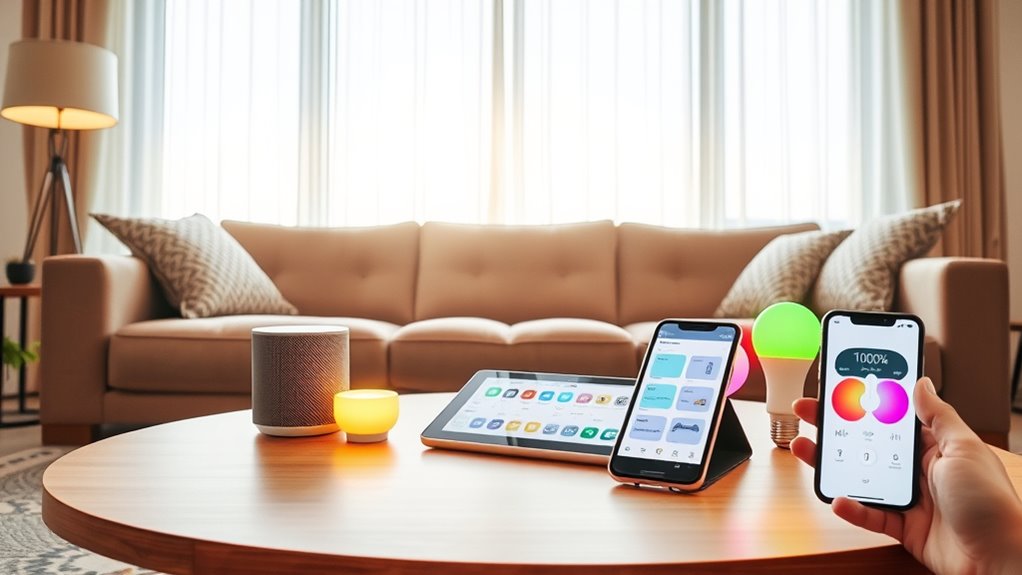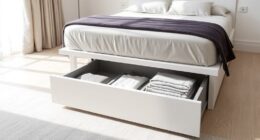Starting simple with home automation is a great way to gain confidence. Begin by choosing easy-to-use devices like smart bulbs or plugs that work with your existing Wi-Fi and are compatible with popular assistants like Alexa or Google. Set up routines such as scheduling lights to turn on at sunset. As you get comfortable, expand gradually and explore more features. Keep learning about key protocols and security—this guide will help you discover what’s next step by step.
Key Takeaways
- Start with easy-to-use devices like smart bulbs or plugs that connect via Wi-Fi for quick setup.
- Focus on one or two automation routines, such as scheduling lights at sunset, to learn system basics.
- Ensure device compatibility with your preferred voice assistant (Alexa, Google, Siri) for seamless control.
- Use a central hub or virtual assistant to manage multiple devices and simplify automation.
- Expand gradually by adding devices that support multiple protocols and integrate into existing routines.
Understanding the Basics of Home Automation

Understanding the basics of home automation is essential before diving into setting up your smart home. A smart home uses devices like smart bulbs, smart plugs, security cameras, and thermostats to give you control over lighting, temperature, and security remotely or automatically. These devices connect through wireless protocols such as Wi-Fi, Z-Wave, or Zigbee, often linking to a central hub or your smartphone. Automation routines allow you to set actions based on time, location, or sensors, making your home more convenient and energy-efficient. Starting simple with a few devices helps you learn how each works and can be expanded gradually. Additionally, familiarizing yourself with wireless protocols ensures you select compatible devices and optimize your setup. Understanding device interoperability can help prevent compatibility issues and streamline your smart home experience. Moreover, knowing how to troubleshoot connectivity problems related to network stability can save you time and frustration. Gaining knowledge about home network security is also crucial to protect your devices and personal data from potential cyber threats. With a solid understanding of these fundamentals, you’ll be ready to customize your smart home setup to fit your needs perfectly.
Choosing Your First Smart Device
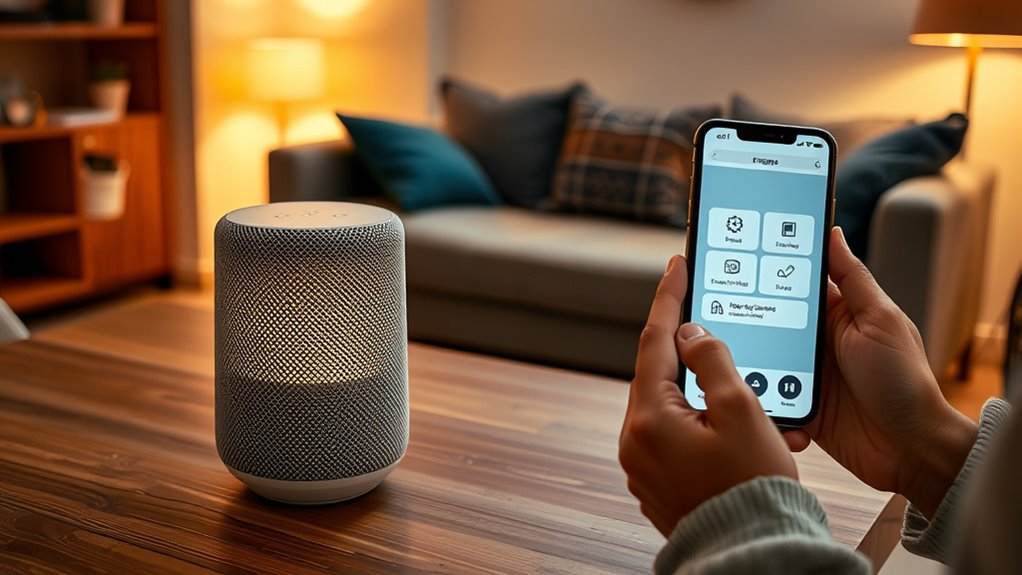
When starting your home automation journey, selecting the right first device can make a significant difference in your experience. Opt for user-friendly options like smart bulbs or smart plugs, which are easy to install and require minimal technical knowledge. These devices often come with easy installation, making them ideal for beginners. Focus on device compatibility with your preferred home automation system and compatible control platforms such as Alexa, Google Assistant, or Apple Siri. Research product reviews, ratings, and buyer guides to find reliable brands like Philips Hue, Wemo, or Ecobee that boast positive user feedback and brand reliability. Consider features like energy monitoring for added convenience, and choose devices with straightforward initial setup. Starting simple with these devices sets a solid foundation for expansion, and understanding compatibility standards will help ensure your devices work seamlessly together while expanding your system effortlessly. Additionally, being aware of smart home protocols can help you select devices that communicate effectively across your network. Knowing about security considerations is also important to protect your smart home from potential vulnerabilities.
Evaluating Key Features and Compatibility
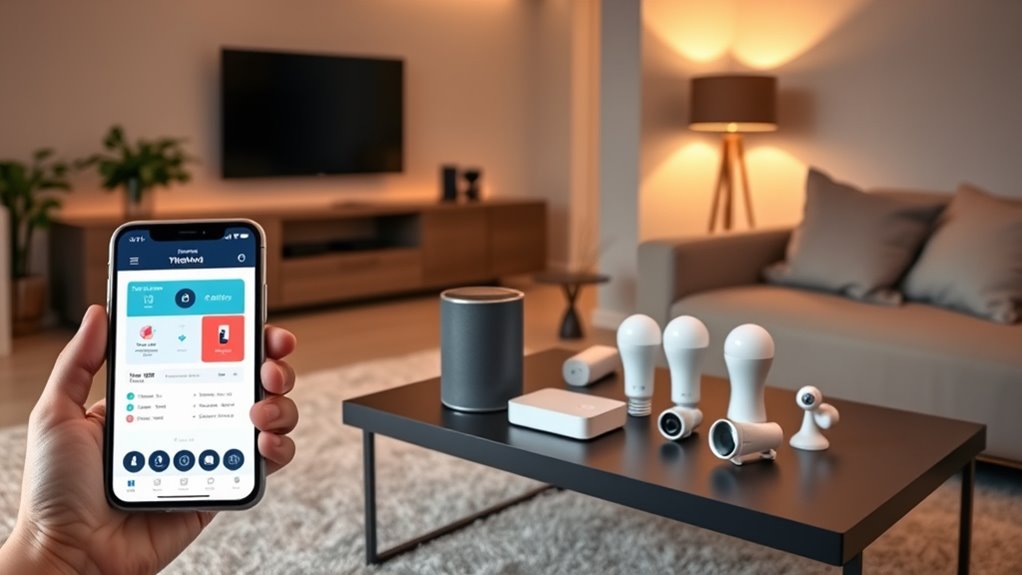
Evaluating the key features and compatibility of smart devices guarantees your home automation system functions smoothly and can grow over time. Focus on compatibility by checking if devices support standards like Z-Wave, Zigbee, or protocols such as Matter, ensuring seamless integration. Incorporating common smart home protocols allows for greater interoperability between devices from different brands. Additionally, consider the availability of high-quality anime movies for entertainment and cultural enrichment within your smart home setup, as integrating multimedia devices can enhance your home experience. Using a central hub that supports various protocols simplifies managing multiple brands within one ecosystem. This cross-platform support enhances scalability, making it easy to add new devices without multiple apps. Regularly reviewing retail store hours can help you plan your smart home upgrades conveniently, especially during sales or holiday promotions. – Feel confident knowing your system adapts as your smart home evolves – Enjoy effortless control across devices and platforms – Secure smooth communication and future growth
Setting Up Your Initial Devices
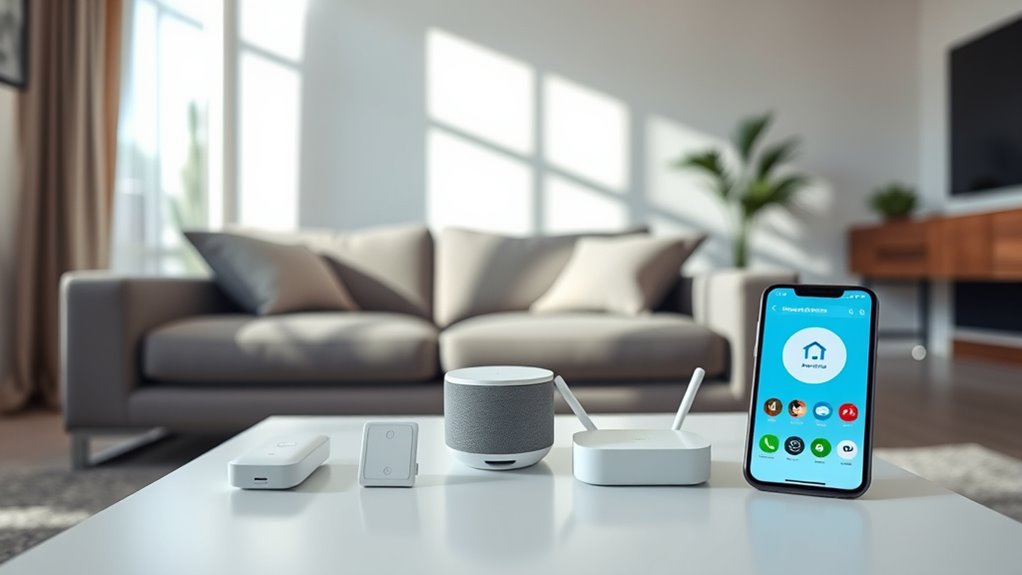
Start by choosing easy-to-use devices like smart bulbs or plugs that work well with your Wi-Fi. Follow the manufacturer’s instructions to connect them to your smartphone app and set up simple routines, like scheduling lights to turn on at sunset. Consider exploring Kia Tuning options to enhance your vehicle’s performance as part of your home automation interests. As you get comfortable, expand your system with additional devices that fit your needs and verify they work smoothly with your existing setup. Be aware that home automation is rapidly evolving, with new devices and features constantly emerging, so staying informed about latest technology trends can help you make better choices. Additionally, understanding juice cleanse and detox principles can inspire health-focused automation in your lifestyle. Incorporating sleep awareness into your routines can also improve your overall well-being as you develop your smart home system.
Choosing Easy-to-Use Devices
Choosing your initial smart devices carefully can make setting up your home automation system much easier. Look for easy-to-use smart devices like smart lights or smart plugs that have straightforward installation and intuitive apps.
Make certain they’re compatible with your voice control system—whether Alexa, Google, or Siri—to simplify setup and daily use. As a beginner, start small with one or two devices to learn the basics without feeling overwhelmed.
Consider devices that:
- Are simple to configure and reliable for new users
- Support routines or scheduling for added convenience
- Offer user-friendly controls for easy management
Reading customer reviews and beginner guides can help confirm your choice. Picking the right, beginner-friendly devices sets you up for a smooth home automation journey. Additionally, selecting devices with user-friendly controls can greatly enhance your initial experience. For better integration, choosing devices that support adaptive learning technologies can help tailor your smart home setup over time. Incorporating standardized protocols ensures compatibility across different brands and future upgrades, making your smart home more versatile. Furthermore, opting for devices with proven reliability can reduce frustration and ensure consistent operation.
Prioritizing Routine Integration
Focusing on routines when setting up your initial smart devices helps you experience immediate benefits and builds a foundation for more complex automation. Start with user-friendly smart home devices that address your daily habits, like a smart bulb or thermostat, to see quick gains. Choose devices compatible with your preferred voice assistants to simplify device linking and setup. Gradually add devices such as motion sensors or smart locks to create initial routines that automate your home seamlessly. Prioritize automation setup that integrates smoothly into your life, making daily tasks effortless. Incorporating the Law of Attraction mindset can help you attract positive outcomes and ease the process of adapting to your new smart home system.
Exploring Voice Control and Smart Speakers
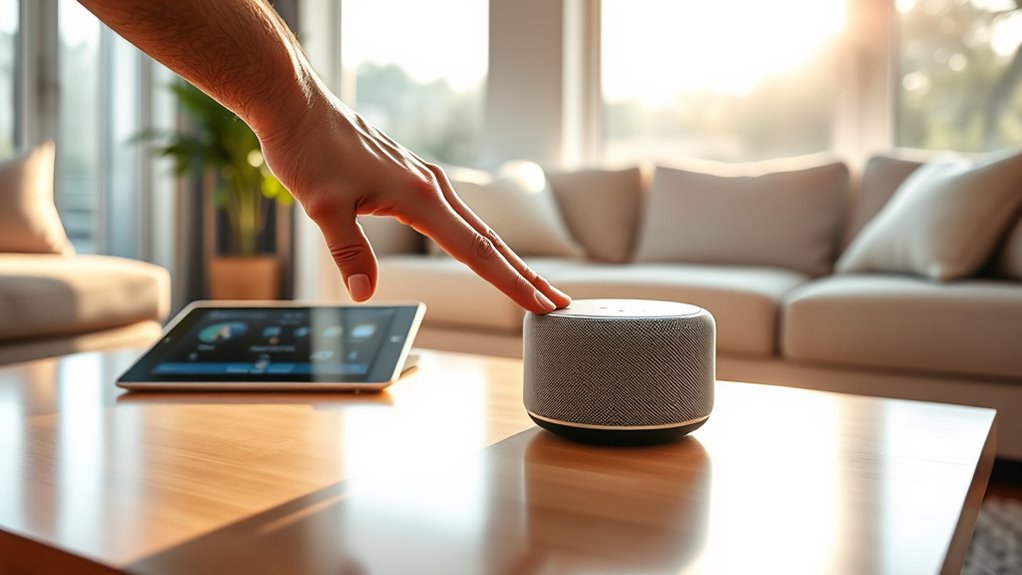
Voice control has become a cornerstone of modern home automation, allowing you to manage smart devices effortlessly through smart speakers like Amazon Echo, Google Nest Audio, and Apple HomePod mini.
Voice control simplifies home automation using smart speakers like Amazon Echo, Google Nest Audio, and Apple HomePod mini.
With voice control, you can turn lights on or off, adjust thermostats, lock doors, and activate routines—all hands-free. Connecting your smart speakers to your Wi-Fi enables seamless integration with your smart home devices, making management quick and intuitive.
Smart displays like Amazon Echo Show or Google Nest Hub combine voice commands with touchscreens, providing visual feedback and easier control.
Imagine feeling empowered by:
- Effortless control of your entire home with just your voice
- Enjoying quick responses and instant access to your smart devices
- Creating a more convenient, connected living environment
Creating Simple Routines and Automations

You can start by setting up basic routines, like turning on lights automatically at sunset or when you enter a room. Automations make daily tasks more convenient, such as scheduling lights to turn off at bedtime or locking doors at a specific time.
Personalize your system by adding triggers like motion sensors to activate cameras or adjust settings when activity is detected.
Basic Routine Setup
Starting with a simple routine is the easiest way to begin automating your home. To create your first automation, select a core smart device like a smart bulb or plug. Use your smart home app to set automation rules based on triggers like time, location, or sensors.
For example, program your lights to turn on at sunset or when you enter a room. You can also use voice commands to activate routines, such as saying “Good morning” to turn on lights, adjust the thermostat, and play music all at once.
Regularly test your automations and tweak settings to make certain they work reliably and suit your household habits. Gradually expand your routines by adding more devices and triggers, making your smart home increasingly convenient.
Automate for Convenience
Automating simple routines can markedly boost your home’s convenience without requiring complex setups. With a smart home, you can use automation to streamline daily tasks through routines and scheduling.
For example, set your smart lighting to turn on at sunset or use motion sensors to automatically light hallways when you enter, enhancing safety and accessibility. Voice commands with virtual assistants let you activate multiple smart devices or scenes with a single phrase, making control effortless.
Linking smart locks and security cameras enables automatic arming or disarming of your security system when you lock or open doors. Using automation apps, you can create custom routines, such as lowering blinds and adjusting the thermostat at bedtime, for comfort and energy savings—all with simple, user-friendly controls.
Personalize With Triggers
Personalizing your smart home becomes simple when you use triggers to create routines and automations that respond to specific events or conditions. With triggers like sensors, scheduled times, or geofencing, you can set up automation that feels personalized and seamless.
Imagine waking up to lights turning on as soon as motion is detected or your thermostat adjusting when you arrive home—these home routines improve comfort and security. By assigning routines to daily activities, you make your smart home adapt effortlessly.
You’ll feel empowered knowing you can:
- *Create automation based on sensor activity or time of day*
- *Use geofencing for a personalized homecoming experience*
- *Design routines that respond instantly to events, making your home smarter*
Expanding Your Smart Home System Gradually
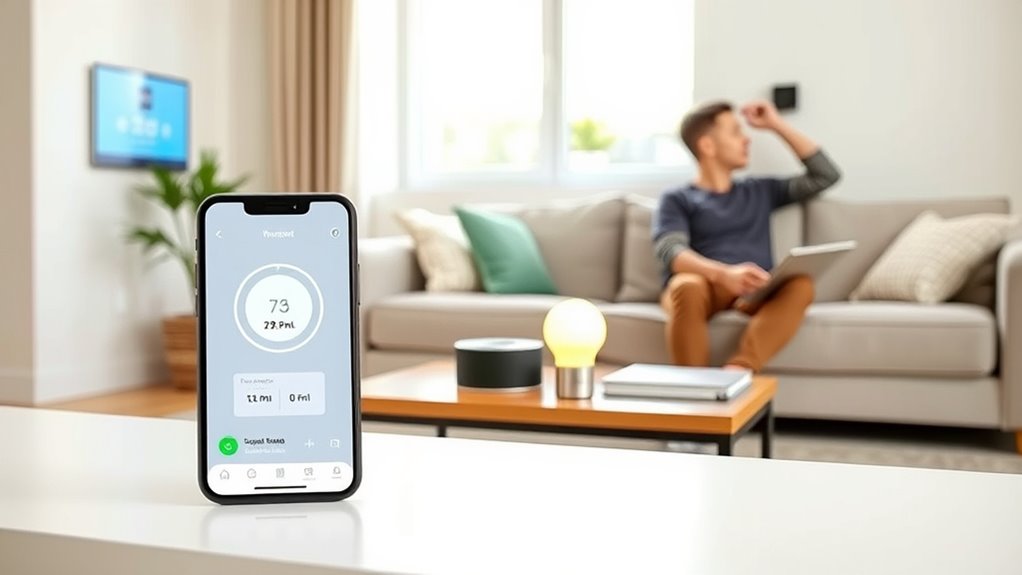
Expanding your smart home gradually helps you manage costs and prevent feeling overwhelmed. Focus on adding compatible devices that support multiple standards like Z-Wave, Zigbee, or WiFi to guarantee smooth device integration.
Prioritize automation routines that connect new devices with existing ones, such as syncing smart lights with security sensors for cohesive control. Use a central hub or virtual assistant to efficiently manage your growing smart home network, making device management easier.
Regularly review and update your security settings and firmware to protect your system from vulnerabilities. By expanding gradually, you gain better control, avoid technical issues, and assure your automation remains seamless and secure as your smart home evolves.
Ensuring Security and Safety in Your Smart Home
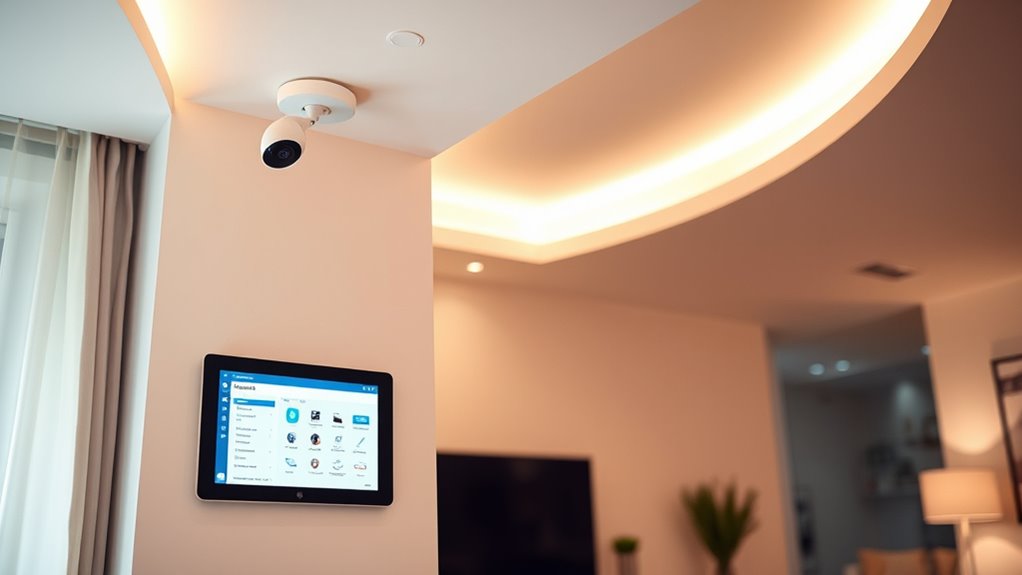
Ensuring security and safety in your smart home requires proactive measures to protect your devices and data. You need to prioritize home security by choosing trusted brands like Ring, Arlo, or Nest for security cameras and smart locks, ensuring reliable video and door security.
Regularly update firmware and software on all devices to fix vulnerabilities. Enable two-factor authentication on your accounts to prevent unauthorized access and review device permissions periodically.
Strengthen your Wi-Fi network with strong, unique passwords or a password manager. Limit device permissions and review connected devices regularly to reduce risks.
- Feel confident knowing your loved ones are safe and secure
- Trust your technology to protect what matters most
- Enjoy peace of mind with a resilient, smart home security system
Frequently Asked Questions
What Is the Cheapest Way to Automate Your Home?
If you want to automate your home on a budget, start simple. Use smart plugs to control your existing appliances for around $15-$30 each.
Replace bulbs with affordable smart options like Wyze or TP-Link Kasa for under $20.
Add a low-cost voice assistant like an Amazon Echo Dot or Google Nest Mini for about $50-$100.
These small steps make automation affordable and easy without breaking the bank.
What Is the Basic Concept of Home Automation?
Imagine your home as a symphony, with each device playing a part in harmony. The basic concept of home automation is that you use smart devices and a central controller to make your house respond automatically or remotely.
You can control lights, thermostats, and security systems with your phone or voice, turning routine tasks into a seamless, effortless flow—creating a more comfortable, efficient living space.
Do You Need a License for Home Automation?
You generally don’t need a license to set up or operate most home automation devices. Licensing is usually only required for professional installation of complex systems like security or surveillance.
In some areas, there might be rules for radio frequency or wireless communication, but these typically don’t apply to personal use.
Always check your local laws, especially if you’re working with RF devices or security features, to stay compliant.
What Is the App That Controls All Smart Home Devices?
You’re probably wondering which app controls all your smart home devices. The answer depends on your ecosystem. Usually, the manufacturer’s app, like Google Home, Amazon Alexa, or Apple Home, manages their devices.
You can also use third-party apps like SmartThings, Hubitat, or Home Assistant for a centralized control hub. These apps support routines, automation, and remote access, making it easier to manage multiple devices from one interface.
Conclusion
Now that you’ve taken your first steps into home automation, imagine the possibilities that lie ahead. As you expand your system, new features and smarter integrations await, promising convenience and control like never before. But be warned—each addition opens doors to unforeseen surprises and challenges. Are you ready to release the full potential of your smart home? The journey has just begun, and the future holds even more exciting innovations just around the corner.
